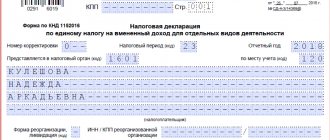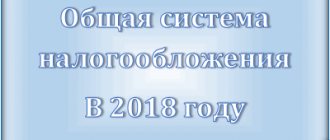By virtue of clause 7 of Art. 346.26 of the Tax Code of the Russian Federation, taxpayers who, along with entrepreneurial activities subject to UTII, carry out other types of activities, are required to keep separate records of property, liabilities and business transactions.
Thus, organizations that carry out several types of activities, using the general taxation system (OSNO) for some types, and a special regime in the form of UTII for others, are faced with the obligation to maintain separate records of business transactions. In turn, for organizations that are on OSNO, such an obligation is due to the need to distribute “input” VAT between taxable and non-taxable transactions. Otherwise (in the absence of separate accounting), the amount of VAT on purchased goods, works, and services is not accepted for deduction and is not included in expenses for the purposes of calculating income tax.
As you may have guessed, the topic of our article is the nuances of the distribution of “input” VAT when carrying out activities within the framework of one organization according to the “OSNO + UTII” scheme. Let's start with chap. 21 Tax Code of the Russian Federation.
The procedure for assigning VAT to costs of production and sale of goods (work, services)
From the analysis of the provisions of paragraph 4 of Art. 170 of the Tax Code of the Russian Federation, the following system is being built for the distribution of “input” VAT to taxpayers carrying out transactions as taxable
(OSNO) and exempt from taxation (UTII).
In relation to goods (works, services), including fixed assets and intangible assets, property rights used:
– in activities transferred to the payment of UTII, the amounts of “input” VAT are taken into account in the cost of such goods (work, services), property rights;
- for carrying out transactions subject to VAT when applying OSNO - are accepted for deduction in accordance with Art. 172 Tax Code of the Russian Federation ;
– simultaneously in both types of activities (OSNO + UTII) – are accepted for deduction or taken into account in their value in the proportion in which they are used in each of these types of activities (in the manner established by the accounting policy for tax purposes).
The specified proportion is determined based on the cost of shipped goods (work, services), property rights, transactions for the sale of which are not subject to taxation (exempt from taxation), in the total cost of goods (work, services), property rights shipped during the tax period.
Please note that for fixed assets and intangible assets accepted for accounting in the first or second months of the quarter, the taxpayer has the right to determine such a proportion based on the cost of goods shipped in the corresponding month (work performed, services rendered) and transferred property rights.
Combination of UTII and OSNO
When entrepreneurs and legal entities register, they choose the mode in which they will work. It can be changed during the activity, but to do this you need to wait for certain deadlines and comply with the conditions.
UTII can only be applied by enterprises of limited areas of activity that comply with the conditions for the application of the imputation. The advantage of UTII is the ability to replace the payment of VAT, property and profit taxes with a single tax. Combining regimes allows you to optimize tax payments and reduce the tax burden, but if you decide to combine these two regimes, be prepared to keep separate records of liabilities, assets and business operations.
OSNO is associated with the payment of income tax, VAT and property tax. If you do not separate your accounting, you may encounter difficulties in calculating the amount of different taxes and subsequent claims from the tax authorities.
It is impossible to combine OSNO and UTII in 2021. From January 1, imputation will be cancelled. Choose a new tax system using our online calculator: enter your parameters to find the most profitable regime. We answered popular questions about the abolition of UTII and the transition period in the article. If you don’t find the answer, ask your question in the comments, we will definitely answer.
Separate accounting settings
When combining the OSNO and UTII taxation modes, check the UTII in the Main section - Settings - Taxes and reports - Taxation system section.
In the VAT , check the following boxes:
- Separate accounting of incoming VAT is maintained;
- Separate VAT accounting by accounting methods.
Check that separate accounting by accounting methods is installed in the section Administration - Program settings - Accounting parameters - Setting up a chart of accounts - Accounting for VAT amounts on purchased values.
The role of accounting policies in organizing separate accounting
The state indicates that separate accounting of OSNO and UTII is mandatory, but does not provide any clear instructions on how to set it up. Therefore, organizations and individual entrepreneurs are forced to independently develop management principles and record them in accounting policies.
In the UE, fix the order:
- division of income and expenses;
- calculation of income tax;
- VAT accounting;
- distribution of property;
- employee distribution;
- proportions of distribution of total income, expenses, property, employees.
It is important to fully disclose these issues in the accounting policy so that during a tax audit the inspector does not have unnecessary questions about tax calculation.
In the UE, prepare the basis for the distribution of income, expenses, fixed assets, VAT and other indicators. To do this, in the working chart of accounts, assign separate sub-accounts for indicators for OSN, UTII and general indicators.
Separate accounting when combining OSNO and UTII
When applying two modes simultaneously, organizations and individual entrepreneurs are required to keep separate records of income and expenses. That is, it is necessary to clearly distinguish between financial flows related to different tax systems in order to correctly calculate taxes for each.
When accounting for the revenue part, problems usually do not arise, since in most cases it is clear what kind of revenue it is and what type of activity it should be attributed to. In accounting, separate sub-accounts are created, which account for sales for each system used separately. When calculating UTII, tax payments will depend on coefficients and physical indicators, and not on the amount of income.
Income tax under the general taxation system is calculated as the difference between income and expenses. Therefore, it is impossible to include expenses that relate to UTII in the OSNO base. This will lead to an underestimation, and the consequence will be an incorrectly calculated tax amount, incorrectly completed reporting, fines and penalties.
When maintaining separate accounting, OSNO payers can submit input VAT for deduction, but only for those transactions that are accounted for under the general system. Input VAT, which relates to activities on UTII, cannot be deducted.
It is also important to divide the property of LLC and individual entrepreneurs between these two systems, since impostors do not pay property tax, with the exception of objects for which the tax is calculated at the cadastral value.
Accounting services from RUB 1,667/month
Taxpayers take into account labor costs for OSNO as expenses when calculating income tax, but do not include them in the OSNO base for employees involved in UTII activities.
The amount of tax can be reduced by the amount of insurance premiums paid for employees engaged in activities on UTII. And contributions that relate to OSNO are taken into account in “profitable” expenses.
Sometimes expenses cannot be attributed to one type of activity, because they apply to all (rent, wages of some employees and other similar payments). In this case, you need to apply the method of proportional distribution of expenses.
The organization of separate accounting when combining UTII and OSNO is necessary primarily for the correct calculation of taxes.
Such accounting is also useful for management needs. A businessman sees separately the financial result for each type of activity and can draw a conclusion about how beneficial the applied tax regimes are for him.
Separate accounting of physical indicators
Imputators know about the importance of the physical indicator for calculating the single tax. An unreasonable overestimation of the indicator can significantly increase the amount of tax that will have to be paid to the budget.
When an indicator is involved in one type of activity and does not affect the calculation of tax for another, there should be no problems with its separation. Provide documented evidence that he is involved only in this activity. For example, you can classify an employee as an imputed activity by specifying his functions and responsibilities in an employment contract, job descriptions, or by drawing up a staffing table.
A business entity involved in several types of activities cannot be divided in accordance with the Tax Code of the Russian Federation. The Ministry of Finance believes that such an indicator should be taken into account in its entirety, but the courts sometimes take the opposite position. But this issue remains controversial, so we recommend following the rules established by law.
Are you switching from UTII? Connect Kontur.Accounting
45% discount in November: RUR 7,590 instead of 13,800 rub. per year of work
Easy bookkeeping
The system itself will calculate taxes and remind you of the deadlines for payments and submission of reports.
Automatic calculation of salaries, vacation pay and sick leave
Technical support 24/7, tips inside the service, reference and legal database
Sending reports via the Internet
Reports and KUDiR are generated automatically based on accounting data
Electronic document management and quick verification of counterparties
Documents, transactions, analytical reports, VAT reconciliation
Separate income accounting
Income received from imputed activities is not taken into account when calculating income tax. Accounting for revenue separately is usually not difficult, because we can say exactly from which line of business the income was received. For a clear division of income, subaccounts for individual types of activities are useful to us.
An enterprise often receives revenue not only from its core activities. Premiums, bonuses and discounts received under contracts within the framework of UTII, as well as surpluses identified during the audit, are classified as income from imputed activities.
The procedure for calculating VAT during the transition from UTII to OSN
Starting from January 1, 2021, an organization that has switched from UTII to OSN must calculate VAT on the sale of goods, performance of work, and provision of services.
If before December 31, 2021, during the period of application of UTII, the organization received an advance payment under a contract, delivery under which is planned for 2021, then VAT is not calculated on the advance payments.
When shipping, starting from January 1, 2021, on account of the advance received, VAT must be calculated in the general manner.
Example. How to calculate VAT when switching from UTII to the general regime. An agreement for the supply of goods was concluded for the amount of 12,000 rubles. In November 2020, the organization received an advance in the amount of RUB 8,000. Shipment under the contract is provided for in February 2021. VAT is calculated only upon shipment in the following order: 12,000 x 20 / 120 = 2,000 rubles. In this case, the invoice should indicate:
- 2,000 rubles – in column 8 “amount of tax presented to the buyer”;
- 12,000 – in column 9 “cost of goods, works, services, property rights with tax - total.”
Let's pay attention!
In contracts for the supply of goods, performance of work, and provision of services concluded in 2021 after January 1, 2021, it is recommended that the price of goods, work, and services be reflected inclusive of VAT.
The Federal Tax Service drew attention to this in a letter dated November 20, 2020 No. CD-4-3/ [email protected]
If the goods are shipped before December 31, 2021 inclusive, then VAT does not need to be calculated, regardless of the date of receipt of payment from customers.
Previously on the topic
Where to migrate with UTII by 2021?
When switching from UTII to OSN, VAT deduction on fixed assets is not allowed
Separate expense accounting
The division of expenses is complicated by the presence of costs that cannot be attributed to one type of activity - general expenses. For example, expenses for salaries and social benefits of administrative and support staff.
Distribute general expenses among areas of activity according to the principle established by Art. 274 Tax Code of the Russian Federation. Imputation expenses are determined in proportions corresponding to the share of income from imputed activities in the total revenue of the organization.
The Ministry of Finance allows you to choose your own distribution method, which must be enshrined in the accounting policy. He proposes to divide expenses depending on the area of the premises in which the activity is carried out (letter No. 03-11-04/3/431). However, tax authorities do not always agree with this, and judicial practice confirms that this decision is controversial. To avoid disputes with tax authorities, check with your inspectorate in advance whether they agree with this distribution.
Determination of distribution proportion
It is generally accepted to distribute total expenses depending on the share of income from a particular type of activity in total revenue. Revenue, according to officials, should be taken into account without including indirect taxes. The period for determining income begins from the beginning of the year and is calculated on an accrual basis. Distribute expenses according to this formula:
Total expenses (TOS) = Total expenses * Income from TOS / Total income
You can divide the costs for UTII using the same formula or simply subtract the result obtained from the total costs.
The Ministry of Finance and the Federal Tax Service do not allow non-operating income to be taken into account when determining the proportion of distribution, because they are not related to production and cannot relate to income from a specific type of activity. The courts do not always agree with their position, but in order to avoid problems it is better to listen to the regulatory authorities.
Input VAT division
Account for input VAT separately so that you can deduct the tax or expense it instead of paying it out of your wallet. To separately account for input VAT, open subaccounts, dividing the tax into three groups:
- VAT on goods used on the OSN - accepted for deduction;
- VAT on goods used for UTII - included in the price;
- VAT on goods used in both modes.
VAT on goods used in both modes must be distributed according to areas of activity. Determine the proportion in which goods are used in one activity. Based on this, take part of the tax as a deduction, and assign the other part to cost. According to Article 170 of the Tax Code of the Russian Federation, the proportion is determined from the cost of goods shipped, subject to VAT, in the total cost of goods shipped during the period. Perform the calculation based on amounts for the quarter, and if the fixed asset was not purchased from the beginning of the quarter, per month.
Controversy surrounding the 5% barrier
According to para. 9 clause 4 art. 170 of the Tax Code of the Russian Federation, the taxpayer has the right not to apply the provisions of this paragraph (that is, not to distribute “input” VAT) to those tax periods in which the share of total expenses for the acquisition, production and (or) sale of goods (work, services), property rights, transactions for the implementation of which are not subject to taxation do not exceed 5% of the total value of aggregate expenses. In this case, the entire amount of “input” VAT in the named tax period is subject to deduction in accordance with the procedure provided for in Art. 172 Tax Code of the Russian Federation .
I would like to note that the issue of the 5% barrier for “imputers” can currently be considered unresolved. The fact is that back in 2005, the regulatory authorities issued letters. From them it followed that the norm provided for in paragraph. 9 clause 4 art. 170 of the Tax Code of the Russian Federation , is applied only by VAT payers, and organizations that are payers of UTII in relation to certain types of activities and for which during the tax period the share of total costs for the production of goods (works, services) sold within the framework of activities subject to UTII does not exceed 5 % of the total amount of total expenses does not have the right to deduct the amount of “input” VAT in full (see letters of the Ministry of Finance of Russia dated July 8, 2005 No. 03-04-11/143 , Federal Tax Service of Russia dated May 31, 2005 No. 03-1-03 /897/ [email protected] , dated 10/19/2005 No. MM-6-03/ [email protected] ). Unfortunately, no later clarifications could be found. There are individual examples in arbitration practice where judges expressed a similar opinion (see, for example, Resolution of the FAS TsO dated May 29, 2006 No. A23-247/06A-14-38 ).
At the same time, there are several examples where judges do not agree with this approach. They recognize as untenable the arguments of the tax authority that the provisions of paragraph. 9 clause 4 art. 170 of the Tax Code of the Russian Federation do not apply to taxpayers transferred to pay UTII (see resolutions of the Federal Antimonopoly Service of the Russian Federation dated 04.03.2009 No. A29-6207/2008 , FAS UO dated 29.10.2008 No. F09-7923/08-S2 , FAS PO dated 05.02.2008 No. A65-28667/06-SA2-11 ).
We believe that if an organization combining two tax regimes (OSNO + UTII) has a share of expenses related to activities for which UTII is paid does not exceed 5% of the total expenses, then it may not calculate the specified proportion and deduct “input » VAT in full. However, she may have to prove her case in court. It follows from arbitration practice that the chances of winning the case on this issue are quite high.
Separate property accounting
Property used in imputed activities is not subject to tax. Except for real estate, for which the tax base is calculated from the cadastral value.
When combining UTII and OSN, keep separate records of property for each type of activity using subaccounts. Separate fixed assets, profitable investments in material assets and depreciation charges. For common property, select a special subaccount.
In order to correctly calculate property tax, and then be able to include part of the tax in expenses or take it as a deduction for individual entrepreneurs, distribute the cost of property used in two directions at the same time. Choose the procedure for distributing the cost and separate accounting of such property yourself and fix it in your accounting policy so that the tax authorities do not force you to pay tax on the full cost of the property.
Author of the article: Elizaveta Kobrina
Keep separate records in the web service for small businesses Kontur.Accounting. Calculate salaries, send reports via the Internet and benefit from the support of our experts. The service itself will calculate taxes, prepare declarations and reports. The first 14 days of work are free, explore the capabilities of the system.
Nuances of separate accounting
So, in paragraph 4 of Art. 170 of the Tax Code of the Russian Federation outlines the basic rules for separate accounting of “input” VAT: if the purchase of goods, works, services relates to operations related to OSNO, VAT is accepted for deduction;
if for transactions related to UTII, the tax is taken into account in the cost of goods, works, services; simultaneously to both OSNO and UTII - it is necessary to calculate the proportion. However, in practice, everything is not so simple and clear, so I would like to look at several examples of situations that taxpayers working under the “OSNO + UTII” scheme often encounter. At the time of receipt of goods, it is unknown in what activity it will be used
Let’s assume that a trading organization sells goods both wholesale (OSNO) and retail (UTII). If at the time of its acquisition it is not possible to determine how many pieces will be sold at retail and how many will be sold wholesale, the accounting policy can provide for the following VAT distribution method. The entire amount of “input” VAT is accepted for deduction. Subsequently, when it is known how many items of goods were sold at retail, this amount, directly related to “UTII activities,” is subject to restoration and payment to the budget. According to the clarifications of the Ministry of Finance ( Letter No. 03-07-11/394 ), this must be done in the tax period in which the purchased goods were sold in retail trade.
Example 1
LLC "Hermes" is engaged in wholesale and retail trade of household electrical appliances. At the same time, a special regime in the form of UTII is applied to retail trade.
On April 1, 2013, the organization purchased 1,000 devices. at a price of 11,800 rubles. (including VAT - 1,800 rubles) for a total amount of 11,800,000 rubles. (including VAT – RUB 1,800,000).
In the second quarter of 2013, Hermes LLC sold the following devices:
– retail – 200 pcs. at a price of 16,000 rubles. in the amount of RUB 3,200,000;
– wholesale – 800 pcs. at a price of RUB 14,160. in the amount of RUB 11,328,000. (including VAT – RUB 1,728,000).
In this case, the organization uses the following sub-accounts opened for account 41 “Goods”: 41-1 “Goods in warehouses”, 41-2 “Goods in retail trade”, 41-3 “Goods in wholesale trade”.
The following entries will be made in the accounting records of Hermes LLC:
| Contents of operations | Debit | Credit | Amount, rub. |
| Purchasing goods | |||
| Goods were received into the warehouse (11,800,000 - 1,800,000) rubles. | 41-1 | 60 | 10 000 000 |
| “Input” VAT on purchased goods is reflected | 19-3 | 60 | 1 800 000 |
| VAT is accepted for deduction | 68 | 19-3 | 1 800 000 |
| Retail sales of goods | |||
| Retail goods sold (RUB 16,000 x 200 pcs.) | 50 | 90-1 | 3 200 000 |
| The purchase price of goods sold at retail is reflected (RUB 10,000 x 200 pcs.) | 41-2 | 41-1 | 2 000 000 |
| VAT accepted for deduction on goods sold at retail has been restored (RUB 1,800 x 200 pcs.) | 19-3 | 68 | 360 000 |
| Recovered VAT is included in the cost of goods sold at retail | 41-2 | 19-3 | 360 000 |
| The cost of goods sold at retail was written off (2,000,000 + 360,000) rubles. | 90-2 | 41-2 | 2 360 000 |
| Selling goods wholesale | |||
| Products sold in bulk (RUB 14,160 x 800 pcs.) | 62 | 90-1 | 11 328 000 |
| VAT charged on wholesale sales | 90-3 | 68 | 1 728 000 |
| Reflects the purchase price of goods sold in bulk | 41-3 | 41-1 | 8 000 000 |
| The cost of goods sold in bulk has been written off | 90-2 | 41-3 | 8 000 000 |







